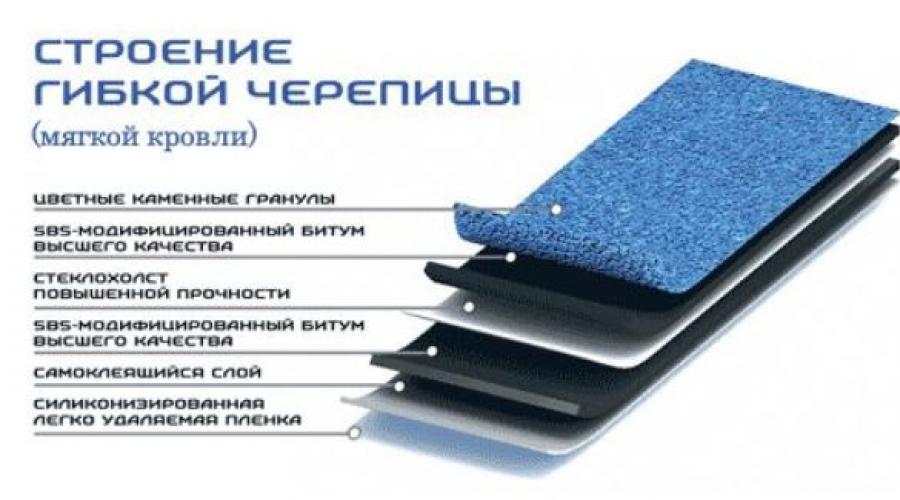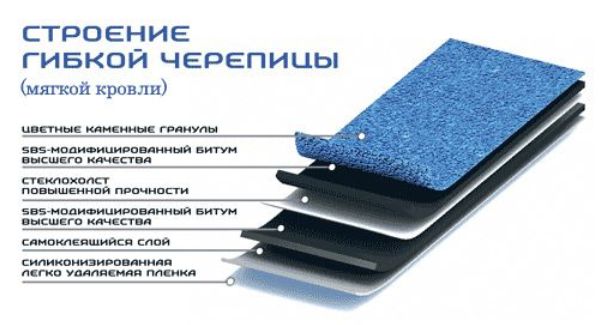Installation of soft tiles: instructions for self-laying

Soft tiles- This is a relatively new and modern material for the roof, which is highly durable and has an aesthetic appearance. The roof laid with soft tiles looks solid and noble, while reliably protecting the house from rain and snow for many years.
Independent is considered a rather complicated technological process. But if you use the advice and recommendations that will be offered in this lesson, as well as take your work seriously and responsibly, then self-installation of a shingle roof will allow you to do without calling a team of builders. And this is a significant financial savings!
Soft tiles: composition and properties of roofing material
The soft tile is that material which belongs to the category of soft roofing coverings. Several names of this material are known: namely, bituminous tiles or tiles, flexible roofing, soft roofing, shinglas.
The structure of soft tiles is a sequence of layers that strictly perform a specific function.

The bottom layer of the tile is the very first layer, consisting of a lining, a film or a sprinkle, and protecting the sheets from sticking together during storage or transportation.
The next layer of soft tiles consists of a bituminous mass, which has a waterproofing function, thereby ensuring the waterproofness of the roof. In order for bitumen to be wear-resistant, elastic and durable, it is oxidized and modified with special polymers. It is this layer of self-adhesive bitumen that is used to bond the tiles to the base of the roof.
The third main layer is a biologically stable fabric, consisting of a material such as polyester or fiberglass. This layer is located between the insulating layers, which provide soft tiles with tensile strength. Laminated soft tiles are also complemented by another layer of fiberglass.
The surface (top layer) of soft tiles is sprinkled with mineral chips or ceramized basalt granulate. This layer is designed to protect the surface of the tile from mechanical damage, reflect sunlight, and is also decorative.
Due to its composition and structure, soft tiles have the following advantages, which ensure its widespread use as a roofing material:
- a light weight;
- high tightness;
- resistance to deformation due to its flexibility and elasticity;
- profitability (after installation, there is almost no excess material left);
- low cost of the material;
- simple installation of a tiled roof.
Soft tiles are produced in the form of plates with a thickness of three to five millimeters, a width of 30 to 45 cm and a length of up to 1 meter. For each manufacturer, flexible tiles differ from others in color, shade or design.
Features of the correct laying of soft tiles on the roof
The installation of soft tiles has some features, the observance of which allows for high-quality installation of this roofing material.
- Only pitched roofs are suitable for laying soft tiles, because. water will stagnate on flat surfaces, which can lead to rotting of the base of the roof under the tiles. The minimum slope of a pitched roof should be 11 degrees. If the angle is smaller, then fit.
- Work on laying shingles must be carried out at a temperature not lower than +10 degrees. If laying will be carried out at low temperatures, it is recommended to heat the lower surface of the flexible tile with a building hair dryer.
- For laying a soft roof, it is necessary that the base be firm and even, with a thickness that depends on the step of the crate. You should not dismantle the old bituminous roof if its surface is intact and even, because it can easily replace the lining carpet when laying new tiles on it.
- To avoid discrepancies in color, it is recommended to buy packages from the same lot, and during installation, take roofing tiles from different packs at the same time. Over time, under the influence of the environment, the pigment will darken slightly, and then the possible shades will smooth out.
- During storage, it is very desirable to protect soft tiles from sunlight and freezing temperatures.

Proper installation of soft tiles with your own hands: laying technology
Before that, work should begin on the qualitative preparation of the base. Installation of soft tiles is carried out on a solid and even crate, the thickness of which depends on the pitch of the rafters. If it is 30 centimeters, then moisture-resistant plywood or oriented strand board (OSB) with a thickness of 9 millimeters is used. With a rafter pitch of 150 centimeters, the thickness of plywood or OSB should be 27 millimeters. Also in this case, you can use an edged board with a thickness of 37 millimeters.
If the pitch of the rafters is 60, 90 or 120 centimeters, then it is necessary to use sheets with a thickness of 12, 18 and 21 millimeters, respectively, or an edged board with a thickness of 20, 23 and 30 millimeters. The pitch of the rafters and battens must be selected based on the expected load on the roof. As a temperature compensation, the size of the gap between sheets of plywood or OSB boards should be no more than 3 mm, and between boards - no more than 5 mm.
It is necessary to achieve perfect smoothness of the base surface, otherwise a thin coating of soft tiles after installation will give out all the flaws and irregularities.
Without fail, check the correctness of the roof insulation, as well as the presence of vapor barrier, wind insulation and properly installed ventilation gaps.

Next, the lining carpet is laid, perpendicular to the slope, starting from the bottom. Moreover, each subsequent strip of material during laying should overlap the underlying one by 10 - 15 centimeters. The lining carpet is fastened to the base of the crate using nails, hammering them in 20 cm increments, the joints between the canvases must be glued with adhesive tape.
![]()
Before starting the installation of soft tiles, it is necessary to mount metal gable and cornice strips (droppers), which will protect the wooden base and crate from moisture. Fastening is done with nails, hammering them in 10 cm increments in a checkerboard pattern.
Then it is necessary to carry out the arrangement of the valleys. The valley strip must be rolled out over the underlayment carpet and after removing the protective film from it, glue it with a self-adhesive layer. Next, it must be nailed along the edge with nails in increments of 10 centimeters.

After completing all the preparatory work, you can begin the installation of a roof made of flexible tiles. The protective film is removed from the bottom of the tile and pressed with a self-adhesive layer to the surface. Then each shingle needs to be nailed in four places so that the caps are covered by the next row of shingles. Be sure to check the geometry of the pattern with a board or thread before final fastening.

Laying soft tiles carried out from the eaves from the center of the slope. The very first row of cornice tiles must be laid at a distance of 2 centimeters from the edge of the cornice. After that, the first layer of soft tiles is laid. Then each next row is laid so that the joints and fasteners of the previous row are closed and the correct pattern is created.
The installation of soft tiles ends with the installation of the ridge. For these purposes, it is necessary to use a special ridge tile. It is also laid on a self-adhesive layer and nailed with an overlap of 5 - 10 centimeters. Particular attention should be paid to the tightness of the roof around pipes, chimneys.
Installation of soft tiles can also be done without removing the old coating. In this case, laying on the old base will be similar to laying tiles from scratch. How to carry out the installation of soft tiles correctly with your own hands can be understood from the video to the article.
Tiled roof maintenance
Competent and timely maintenance significantly increases the life of a roof made of flexible tiles. It is necessary to check its condition every autumn and spring, replacing or gluing individual tiles in order to exclude the occurrence of leaks. Rubbish that has fallen on the roof must be swept away, and stones, pieces of glass and metal should be carefully removed with your hands. After all, the price of such a careful attitude to a soft tile roof is its long service life!